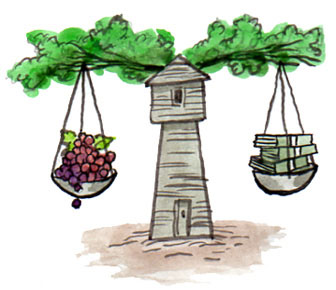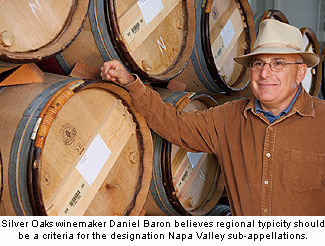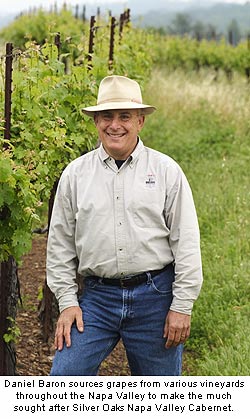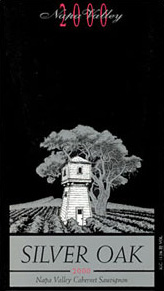

Are the prices of sub-AVA designated wines in balance
with their quality? Or is the subdivision of the Napa Valley
merely a tool for charging more?
Silver Oak's Daniel Baron Weighs in on the Appellation Debate
"For sub-appellations to be viable, there has to be typicity, before what the TTB says. The wines from a certain area need to taste like each other."
~ Daniel Baron, winemaker – Silver Oak Cellars
by
Alan Goldfarb
September 19, 2006
Alan Goldfarb (AG): You’ve told me that you’re not a believer in the sub-AVA (American Viticulture Area) system. You said, “Some wineries are making worse wines because they’re sourcing fruit from a sub-appellation.”
 Daniel Baron (DB): I’m not a proponent of the sub-appellations of Napa County. One of the problems with the ways the AVAs are administered is that wine typicity is not one of the criteria. Unlike the process in Bordeaux, for instance, the TTB (Tax & Trade Bureau) considers AVAs as viticulture areas that are based on elevation and on soil types, not wine typicity.
Daniel Baron (DB): I’m not a proponent of the sub-appellations of Napa County. One of the problems with the ways the AVAs are administered is that wine typicity is not one of the criteria. Unlike the process in Bordeaux, for instance, the TTB (Tax & Trade Bureau) considers AVAs as viticulture areas that are based on elevation and on soil types, not wine typicity.
It’s a bit senseless and arbitrary and it seems particularly egregious in an appellation. Our predecessors and now we have worked very hard to establish the Napa Valley (as a whole) as one of the best wine regions in the world.
They’re [the sub-AVAs] supposed to give more information to the consumer, but it’s just a marketing tool for wineries to charge more money for their wine. It’s a disservice to the consumer and to their fellow winemakers. At some point the consumer will wake up and say, “why am I paying more for a wine that isn’t good?”
AG: But yet, you put “Alexander Valley” on your labels and that’s a sub-appellation of Sonoma County.
DB: Appellations in Sonoma County are much bigger pieces of land and do have much more personality. There are some real differences. Smaller appellations (sub-AVAs) are much more limited in Sonoma … and there are some artificial decisions that are being made there.
AG: So, you think that the sub-AVA system is all about marketing?
DB: I’m always suspicious when marketing is driving winemaking decisions.
AG: Do you think the TTB will be petitioned to change its criteria as it pertains to sub-AVAs and the issue of wine typicity?
DB: I don’t think that will happen. I think the marketplace will sort it out. Consumers will be drawn to the producers who continue to make great wine.
AG: Then, will we ever see wines of terroir as long as the sub-appellation system is in its present order?
DB: Yes, of course. But I think we need to be leery of bombarding the consumer with too much information. There was a survey recently that said that a majority of consumers don’t even know what the vintage date means. Why should we give them more information, such as a sub-AVA? Let’s hope they remember the name of our winery and like our wines because of its quality.
For sub-appellations to be viable, there has to be typicity, before what the TTB says. The wines from a certain area need to taste like each other. We’re a little hard-put to taste Oakville wines that are different from those from Rutherford, for instance. I think there’s more variation between producers.
AG: What would you like to see happen as it pertains to sub-regions?
DB: I haven’t really thought far enough ahead. But when I’m making wines; when I’m blending, I celebrate the fact that I balance the Napa Valley blend. (i.e.) How much is Oakville, how much is Rutherford?
 AG: What are your Napa Valley grape sources?
AG: What are your Napa Valley grape sources?
DB: The whole appellation of Napa Valley, wherever Cabernet grows, from Redwood Road to Dunaweal Lane to Foss Valley to the foothills on the west side.
AG: Do you have long-term contracts?
DB: Always. We buy fruit from Doug Hill on top of Soda Canyon Road (near Atlas Peak), from Ernie Navone in St. Helena and from Tom Hsieh on Dry Creek Road.
We own 100 acres of our own on Soda Canyon off the Silverado Trail where we grow Merlot and Cab Franc. Those go into Twomey and the Merlot goes to Silver Oak.
AG: Compare and contrast your wines from the Alexander Valley and those you make from the Napa Valley.
DB: The Alexander Valley is softer, more fruit forward. It’s more pleasurable drinking in its youth, but might not have the longevity (of the Napa Valley).
The Napa is more intense and structured and takes longer to open up. Napa tends to have tobacco and chocolate. Alexander has more fruit – blackberry and cassis.
AG: Why do those differences exist?
DB: The soils are different and the climate is different. Alexander Valley is warmer, with richer, deeper soils. In Napa, there are volcanic and more depleted soils and we also have the maritime influence.
I’m referring here to viticulture factors. They’re primal in order to determine typicity. But you have to follow that out to ensure the regional character is borne out.
If you want to hitch your horse to an appellation, what we need to do adjust our winemaking so that’s appropriate to each of the two appellations. We have a longer aging program with the Napa so the wine has another six months in bottle. And we blend other varieties in the Napa – Cab Franc, Merlot, Petit Verdot. The Alexander is pure Cabernet.
AG: Don’t you have a vineyard in Oakville?
DB: Yes. It’s 12 acres of Cabernet, surrounding the winery that we sell to another (undisclosed) winery.
AG: Why not use that fruit?
DB: This was originally a dairy. It has deeper soils, and is near the river and it doesn’t make particularly rich red wines so it’s not up to the quality of our blend.
AG: Do you think you’ll ever make an Oakville designated wine?
DB: I can’t rule it out. If we acquire To Kalon, for instance. If I had a single v
 Daniel Baron (DB): I’m not a proponent of the sub-appellations of Napa County. One of the problems with the ways the AVAs are administered is that wine typicity is not one of the criteria. Unlike the process in Bordeaux, for instance, the TTB (Tax & Trade Bureau) considers AVAs as viticulture areas that are based on elevation and on soil types, not wine typicity.
Daniel Baron (DB): I’m not a proponent of the sub-appellations of Napa County. One of the problems with the ways the AVAs are administered is that wine typicity is not one of the criteria. Unlike the process in Bordeaux, for instance, the TTB (Tax & Trade Bureau) considers AVAs as viticulture areas that are based on elevation and on soil types, not wine typicity.It’s a bit senseless and arbitrary and it seems particularly egregious in an appellation. Our predecessors and now we have worked very hard to establish the Napa Valley (as a whole) as one of the best wine regions in the world.
They’re [the sub-AVAs] supposed to give more information to the consumer, but it’s just a marketing tool for wineries to charge more money for their wine. It’s a disservice to the consumer and to their fellow winemakers. At some point the consumer will wake up and say, “why am I paying more for a wine that isn’t good?”
AG: But yet, you put “Alexander Valley” on your labels and that’s a sub-appellation of Sonoma County.
DB: Appellations in Sonoma County are much bigger pieces of land and do have much more personality. There are some real differences. Smaller appellations (sub-AVAs) are much more limited in Sonoma … and there are some artificial decisions that are being made there.
AG: So, you think that the sub-AVA system is all about marketing?
DB: I’m always suspicious when marketing is driving winemaking decisions.
AG: Do you think the TTB will be petitioned to change its criteria as it pertains to sub-AVAs and the issue of wine typicity?
DB: I don’t think that will happen. I think the marketplace will sort it out. Consumers will be drawn to the producers who continue to make great wine.
AG: Then, will we ever see wines of terroir as long as the sub-appellation system is in its present order?
DB: Yes, of course. But I think we need to be leery of bombarding the consumer with too much information. There was a survey recently that said that a majority of consumers don’t even know what the vintage date means. Why should we give them more information, such as a sub-AVA? Let’s hope they remember the name of our winery and like our wines because of its quality.
For sub-appellations to be viable, there has to be typicity, before what the TTB says. The wines from a certain area need to taste like each other. We’re a little hard-put to taste Oakville wines that are different from those from Rutherford, for instance. I think there’s more variation between producers.
AG: What would you like to see happen as it pertains to sub-regions?
DB: I haven’t really thought far enough ahead. But when I’m making wines; when I’m blending, I celebrate the fact that I balance the Napa Valley blend. (i.e.) How much is Oakville, how much is Rutherford?
 AG: What are your Napa Valley grape sources?
AG: What are your Napa Valley grape sources? DB: The whole appellation of Napa Valley, wherever Cabernet grows, from Redwood Road to Dunaweal Lane to Foss Valley to the foothills on the west side.
AG: Do you have long-term contracts?
DB: Always. We buy fruit from Doug Hill on top of Soda Canyon Road (near Atlas Peak), from Ernie Navone in St. Helena and from Tom Hsieh on Dry Creek Road.
We own 100 acres of our own on Soda Canyon off the Silverado Trail where we grow Merlot and Cab Franc. Those go into Twomey and the Merlot goes to Silver Oak.
AG: Compare and contrast your wines from the Alexander Valley and those you make from the Napa Valley.
DB: The Alexander Valley is softer, more fruit forward. It’s more pleasurable drinking in its youth, but might not have the longevity (of the Napa Valley).
The Napa is more intense and structured and takes longer to open up. Napa tends to have tobacco and chocolate. Alexander has more fruit – blackberry and cassis.

AG: Why do those differences exist?
DB: The soils are different and the climate is different. Alexander Valley is warmer, with richer, deeper soils. In Napa, there are volcanic and more depleted soils and we also have the maritime influence.
I’m referring here to viticulture factors. They’re primal in order to determine typicity. But you have to follow that out to ensure the regional character is borne out.
If you want to hitch your horse to an appellation, what we need to do adjust our winemaking so that’s appropriate to each of the two appellations. We have a longer aging program with the Napa so the wine has another six months in bottle. And we blend other varieties in the Napa – Cab Franc, Merlot, Petit Verdot. The Alexander is pure Cabernet.
AG: Don’t you have a vineyard in Oakville?
DB: Yes. It’s 12 acres of Cabernet, surrounding the winery that we sell to another (undisclosed) winery.
AG: Why not use that fruit?
DB: This was originally a dairy. It has deeper soils, and is near the river and it doesn’t make particularly rich red wines so it’s not up to the quality of our blend.
AG: Do you think you’ll ever make an Oakville designated wine?
DB: I can’t rule it out. If we acquire To Kalon, for instance. If I had a single v














